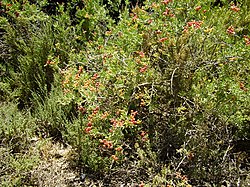Nitraria
| Nitraria subsp. var. | ||||||||||||||||||||||||||||||||||||||||||||||||||||||||
|---|---|---|---|---|---|---|---|---|---|---|---|---|---|---|---|---|---|---|---|---|---|---|---|---|---|---|---|---|---|---|---|---|---|---|---|---|---|---|---|---|---|---|---|---|---|---|---|---|---|---|---|---|---|---|---|---|

|
|
| ||||||||||||||||||||||||||||||||||||||||||||||||||||||
| ||||||||||||||||||||||||||||||||||||||||||||||||||||||||
Nitraria is a genus of flowering plants in the family Nitrariaceae, native to Africa, Europe, Asia, Russia and Australia.
| Standard Cyclopedia of Horticulture |
|---|
|
Nitraria (Latin nilrum, natron; in reference to its habitat in nitrous soil). Zygophyllaceae. Niterbush. Four low rigid shrubs distributed from S. Russia to Mongolia, W. China and Persia and through Asia Minor to Arabia and N. Afr., with alternate small fleshy, entire or dentate, stipulate Lvs. and with small white or yellowish green fls. in terminal cymes followed by berry-like drupes: calyx 5-parted; fleshy; petals 5, concave; stamens 15; ovary superior, conic-oblong, attenuated into a very short style with 3 connivent stigmas, 2-6-celled: fr. an ovoid drupe with a sculptured 1-seeded stone dehiscent at the apex; cotyledons often 3. The following species is sometimes cult, in European botanic gardens and has been intro. recently by the Dept. of Agric. into this country and recommended as a sand-binder for cooler semi-arid regions; its fleshy fr. is edible. Prop, by seeds and by layers. It is of difficult cult, under ordinary conditions, as it is, like most desert plants, impatient of too much moisture and seedlings particularly are liable to damp off. It grows well in saline and alkaline soils; in ordinary soil an application of salt is recommended to grow it successfully.
|
Cultivation
Propagation
Pests and diseases
Species
There are about 9 species including:
- Nitraria billardierei DC. , known as Nitre Bush or Dillon Bush
- Nitraria retusa (Forssk.) Asch.
- Nitraria schoberi L.
- Nitraria sibirica Pall.
Gallery
-
photo 1
-
photo 2
-
photo 3
References
- Standard Cyclopedia of Horticulture, by L. H. Bailey, MacMillan Co., 1963
External links
- w:Nitraria. Some of the material on this page may be from Wikipedia, under the Creative Commons license.
- Nitraria QR Code (Size 50, 100, 200, 500)
